
Virtua Fighter is a fighting game created for the Sega Model 1 arcade platform by AM2, a development group within Sega, headed by Yu Suzuki. An early prototype version was location tested in Japan by August 1993, before the complete game was released worldwide in December 1993. It is the first game in the Virtua Fighter series, and the first arcade fighting game to feature fully 3D polygon graphics. The game has been ported to several platforms including the Sega Saturn, Sega 32X, and Microsoft Windows.
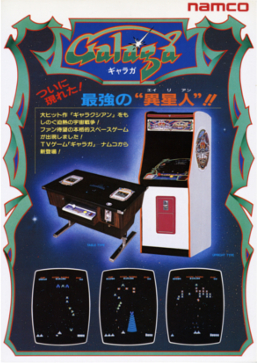
Galaga is a 1981 fixed shooter arcade video game developed and published by Namco. In North America, it was released by Midway Manufacturing. It is the sequel to Galaxian (1979), Namco's first major video game hit in arcades. Controlling a starship, the player is tasked with destroying the Galaga forces in each stage while avoiding enemies and projectiles. Some enemies can capture a player's ship via a tractor beam, which can be rescued to transform the player into a "dual fighter" with additional firepower.

Dig Dug is a maze arcade video game released by Namco in 1982. It was distributed in North America by Atari, Inc. The player digs underground tunnels to attack enemies in each level, by either inflating them to bursting or crushing them underneath rocks.

Xevious is a vertically scrolling shooter arcade video game developed and published by Namco in 1982. It was released in Japan by Namco and in North America by Atari, Inc. Controlling the Solvalou starship, the player attacks Xevious forces before they destroy all of mankind. The Solvalou has two weapons at its disposal: a zapper to destroy flying craft, and a blaster to bomb ground installations and enemies. It runs on the Namco Galaga arcade system.
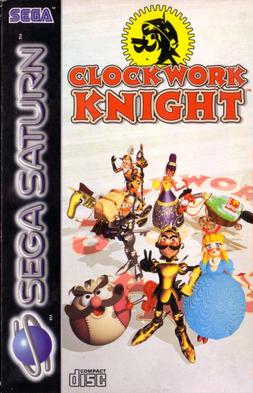
Clockwork Knight is a side-scrolling platform video game developed and published by Sega for the Sega Saturn. It was released in Japan on December 9, 1994, and as a launch title in North America and Europe, on May 11 and July 8, 1995, respectively. It was followed by Clockwork Knight 2.

Virtua Racing or V.R. for short, is a Formula One racing video game developed by Sega AM2 and released for arcades in 1992. Virtua Racing was initially a proof-of-concept application for exercising a new 3D graphics platform under development, the "Model 1". The results were so encouraging that Virtua Racing was fully developed into a standalone arcade title.

Primal Rage is a fighting game developed and released by Atari Games for arcades in 1994. The game takes place on a post-apocalyptic version of Earth called "Urth". Players control one of seven prehistoric beasts, that battle each other to determine the planet's fate. Matches feature many of the conventions of fighting games from the era, including special moves and gory finishing maneuvers. Ports were released for home video game consoles and personal computers. Efforts to perfectly emulate the arcade original have been unsuccessful due to the use of an unusual copy protection method. Toys, comics, a novel and other merchandise tie-ins were produced. More than 1.5 million copies of the game were sold.

Air Combat is a 1995 combat flight simulation video game developed and published by Namco for the PlayStation. Players control an aircraft and are tasked with completing a series of missions, with objectives ranging from destroying formations of enemies to protecting a specific target from enemy fire. Missions award money that is used to purchase new fighter aircraft, each with its own unique weapons and strengths.
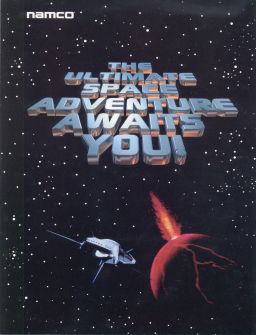
Galaxian3: Project Dragoon is a 3D rail shooter video game developed and published by Namco. It was originally a theme park attraction designed for the International Garden and Greenery Exposition in Japan, and was later released as an arcade game in 1992. The game involves players controlling a starship named the Dragoon in its mission to destroy Cannon Seed, a superweapon set to destroy what is left of the human race.

Rad Mobile is a racing arcade game developed by Sega AM3 and published by Sega. It was first published in Japan in October 1990, followed by an international release for arcades in February 1991. Rad Mobile was Sega's first 32-bit game, using Sega's System 32 arcade system board. It was also the first appearance of Sonic the Hedgehog, who appears as an ornament hanging from the driver's rearview mirror.
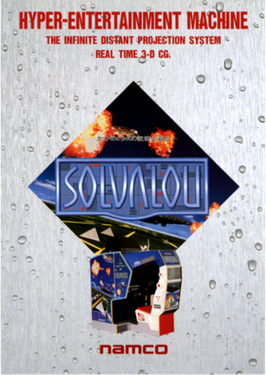
Solvalou is a 1991 first-person rail shooter arcade game developed and published in Japan by Namco. The sixth entry in the Xevious series, the player takes control of the Solvalou starship from a first-person perspective as it must destroy the Xevious forces before they take control of Earth. The Solvalou has two weapon types: an air zapper to destroy air-based enemies, and a blaster bomb to destroy ground-stationed enemies. It runs on the Namco System 21 arcade board.

Ace Driver is a 1994 racing arcade game developed and published by Namco. The player controls a Formula One racer, with the objective being to complete three laps of a race course and to avoid a collision with opponents and other obstacles. Three difficulty levels are available, as is a mode to enable a gear shift. Similar to Namco's own Final Lap series, the arcade cabinet can be linked together with another unit to enable eight-person multiplayer. It ran on the Namco System 22 arcade hardware.
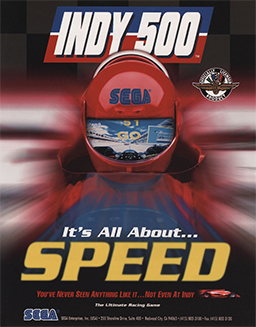
Indy 500 is a 1995 arcade racing game developed by Sega AM1. Based on the IndyCar Series, the game possesses a license from the Indianapolis Motor Speedway, home of the Indianapolis 500, and includes the speedway as one of its courses. Indy 500 was AM1's second game developed using 3D computer graphics and their first to utilize color textures. While planned as a Model 3 arcade system board release, delays in the hardware's completion led to use of the Model 2 instead. A Sega Saturn port was planned, but later canceled. Reception to Indy 500 was mixed, with some critical comparison to other games such as Sega AM2's Daytona USA and Namco's Ace Driver and Rave Racer.

Super Monaco GP is a Formula One racing simulation video game released by Sega, originally as a Sega X Board arcade game in 1989, followed by ports for multiple video game consoles and home computers in the early 1990s. It is the sequel to the 1979 arcade game Monaco GP. The arcade game consists of one race, the Monaco Grand Prix, but later ports added more courses and game modes based on the 1989 Formula One World Championship.

Tekken (鉄拳) is a fighting game developed and published by Namco. It was originally released for arcades in 1994, and ported to the PlayStation the following year. The game was well-received by critics. It is the first entry in the Tekken series, with a sequel, Tekken 2, being released in 1995.

Cyber Sled is a vehicular combat video game developed and published by Namco. It was originally released for arcades in 1993. The game's perspective is third-person by default, but can be switched to a first-person perspective. The game was nominated for Most Innovative New Technology at the 1994 AMOA Awards. It later received a sequel in 1994, Cyber Commando.
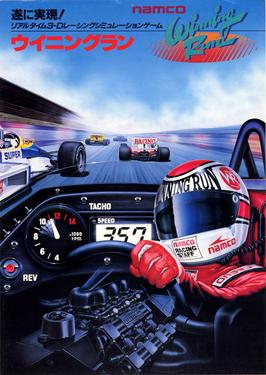
Winning Run is a first-person arcade racing simulation game developed and published by Namco in late December 1988 in Japan, before releasing internationally the following year. The player pilots a Formula One racer, with the objective being to complete each race in first place, all while avoiding opponents and other obstacles, such as flood-hit tunnels, pits and steep chambers. It was the first game to run on the Namco System 21 arcade hardware, capable of 3D shaded polygons.

Samurai Shodown, known in Japan as Samurai Spirits, is a fighting game developed and published by SNK for the Neo Geo arcade and home platform. Released in 1993, it is the first installment in the Samurai Shodown series. In contrast to other fighting games at the time, which were set in modern times and focused primarily on hand-to-hand combat, Samurai Shodown is set in feudal-era Japan and was SNK's first arcade fighting game to focus primarily on weapon-based combat.

Thunder Ceptor is a 3D rail shooter arcade game that was released by Namco in 1986. It usurped both Libble Rabble and Toy Pop as the company's most powerful 8-bit arcade games, was the first game from them to use an analogue (360-degree) joystick. A stereoscopic 3-D sequel, 3-D Thunder Ceptor II, was released towards the end of the year.

Starblade: Operation Blue Planet is an unreleased 3D rail shooter arcade game in development by Namco. A sequel to the game Starblade (1991), the player controls the GeoCalibur starship in its mission to wipe out an alien race known as the Unknown Intelligent Mechanized Species. Gameplay involved using a flight-yoke controller to control a crosshair and shoot down enemies, while avoiding incoming obstacles and projectiles. The player has a shield that depletes when inflicted with enemy fire. Only one level was completed. It ran on the PlayStation 2-based Namco System 246 arcade hardware.






















